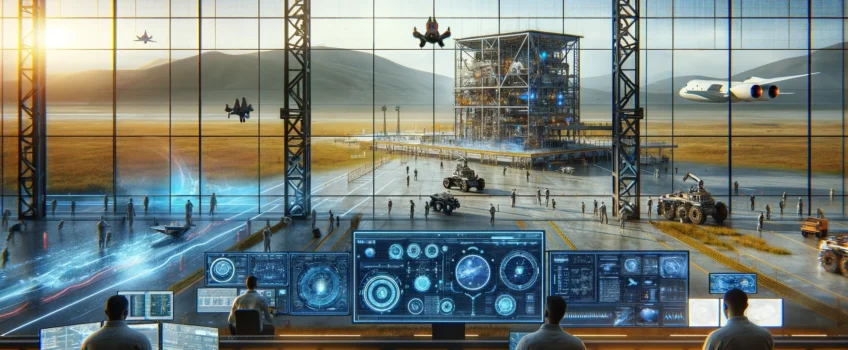
The aerospace engineering field is at the forefront of technological innovation, constantly evolving to meet the demands of modern aviation and space exploration. In recent years, artificial intelligence (AI) and robotics have emerged as pivotal technologies, revolutionising various aspects of aerospace engineering. This article explores how AI and robotics are transforming the industry, enhancing efficiency, precision, and safety.
AI in Aerospace Engineering
Predictive Maintenance
Predictive maintenance is a game-changer in aerospace engineering. Utilising AI algorithms, predictive maintenance analyses data from aircraft sensors to foresee potential failures. This pre-emptive approach allows engineers to address issues before they become critical, significantly reducing downtime and improving safety.
For instance, AI can monitor engine performance and predict when a component might fail, allowing for timely replacement. This proactive maintenance strategy not only ensures the aircraft’s reliability but also leads to substantial cost savings by preventing unexpected breakdowns and expensive repairs.
Design Optimisation
AI is also transforming the design phase of aerospace engineering. Through machine learning models, AI can simulate various design scenarios and optimise aerodynamics, materials, and structural integrity. This capability allows engineers to create more efficient and robust aircraft designs.
The benefits of AI-driven design optimisation are manifold. Engineers can reduce material waste, shorten development cycles, and enhance overall performance. For example, AI can suggest design modifications that improve fuel efficiency or reduce the weight of an aircraft, leading to significant operational savings and environmental benefits.
Robotics in Aerospace Engineering
Assembly Processes
Robotics plays a crucial role in the assembly processes of aerospace engineering. Modern robotic systems perform tasks such as welding, drilling, and fastening with unmatched precision and speed. This integration enhances the efficiency and accuracy of assembling aircraft components.
One notable advantage of using robotics in assembly is the reduction of human error. Robots can work tirelessly with consistent precision, ensuring that each part is assembled to exact specifications. This leads to improved quality control and a reduction in production time, ultimately resulting in more reliable and safer aircraft.
Inspection and Maintenance
Robotic systems are also invaluable for aircraft inspection and maintenance. Advanced robotics can conduct non-destructive testing, inspect hard-to-reach areas, and perform maintenance tasks with high precision. These capabilities are essential for ensuring the structural integrity and safety of aircraft.
For example, robotic arms equipped with sensors can inspect the fuselage for cracks or other signs of wear that might be missed by human inspectors. Similarly, drones can perform detailed inspections of aircraft exteriors, providing real-time data and reducing the need for time-consuming manual inspections.
Future Trends in Aerospace Engineering
Emerging Trends
The future of aerospace engineering will see even greater integration of AI and robotics. Emerging trends include the use of AI for autonomous flight operations and advanced robotics for space exploration. These innovations will continue to push the boundaries of what is possible in aerospace engineering.
AI-driven autonomous flight systems could revolutionise air travel by enhancing safety and efficiency. These systems can make real-time decisions based on vast amounts of data, optimising flight paths and managing in-flight emergencies. Meanwhile, robotics will play a crucial role in space missions, performing tasks that are too dangerous or complex for human astronauts.
Research and Development
Ongoing research and development are critical to the advancement of AI and robotics in aerospace engineering. Universities, private companies, and government agencies are investing heavily in these technologies, driving innovation and creating new opportunities for the aerospace industry.
For instance, research is underway to develop AI systems that can learn and adapt to new situations autonomously, further enhancing their utility in aerospace applications. Similarly, advancements in robotics are focusing on improving dexterity, strength, and autonomy, enabling robots to perform increasingly complex tasks in both manufacturing and operational settings.
3D Printing in Aerospace Engineering
Another significant trend in aerospace engineering is the use of 3D printing. This technology allows for the rapid production of complex and lightweight parts, making it ideal for aerospace applications. Combining AI and robotics with 3D printing can lead to even more efficient and cost-effective manufacturing processes.
For example, AI algorithms can analyse data from sensors during the 3D printing process, ensuring the structural integrity and quality of the final product. Moreover, robotics can automate post-processing tasks such as polishing and painting, further streamlining production processes.
Recommended: How 3D Printing is Transforming Manufacturing
Final Thoughts from PRV Engineering
The integration of AI and robotics is transforming aerospace engineering, bringing unprecedented levels of precision, efficiency, and innovation. As these technologies continue to evolve, they will play an even more significant role in shaping the future of aviation and space exploration. Embracing AI and robotics is not just an option but a necessity for the aerospace industry to remain competitive and continue its legacy of innovation.
So, it is crucial for engineers and researchers to stay updated on the latest advancements in these fields and harness their potential to drive further progress in aerospace engineering. As a leading provider of precision engineering solutions for the aerospace industry, PRV Engineering remains committed to staying at the forefront of technological developments and delivering cutting-edge solutions to our clients. Visit our website for more information or contact us to discuss your project requirements.


 Mail:
Mail: 



